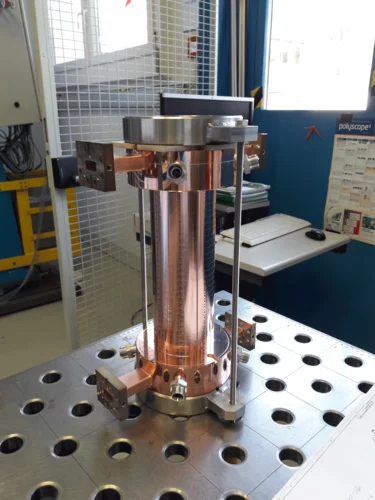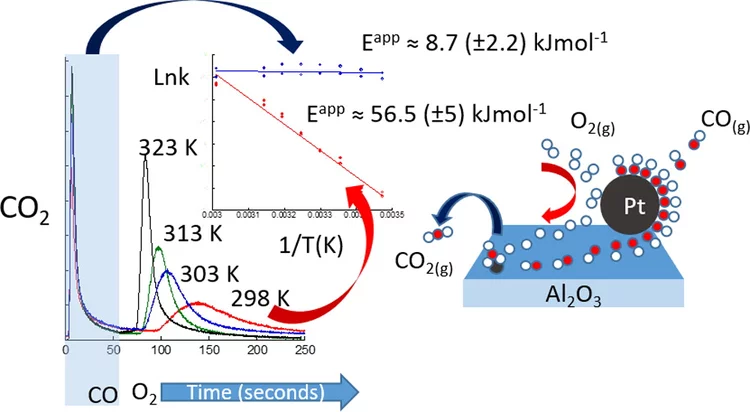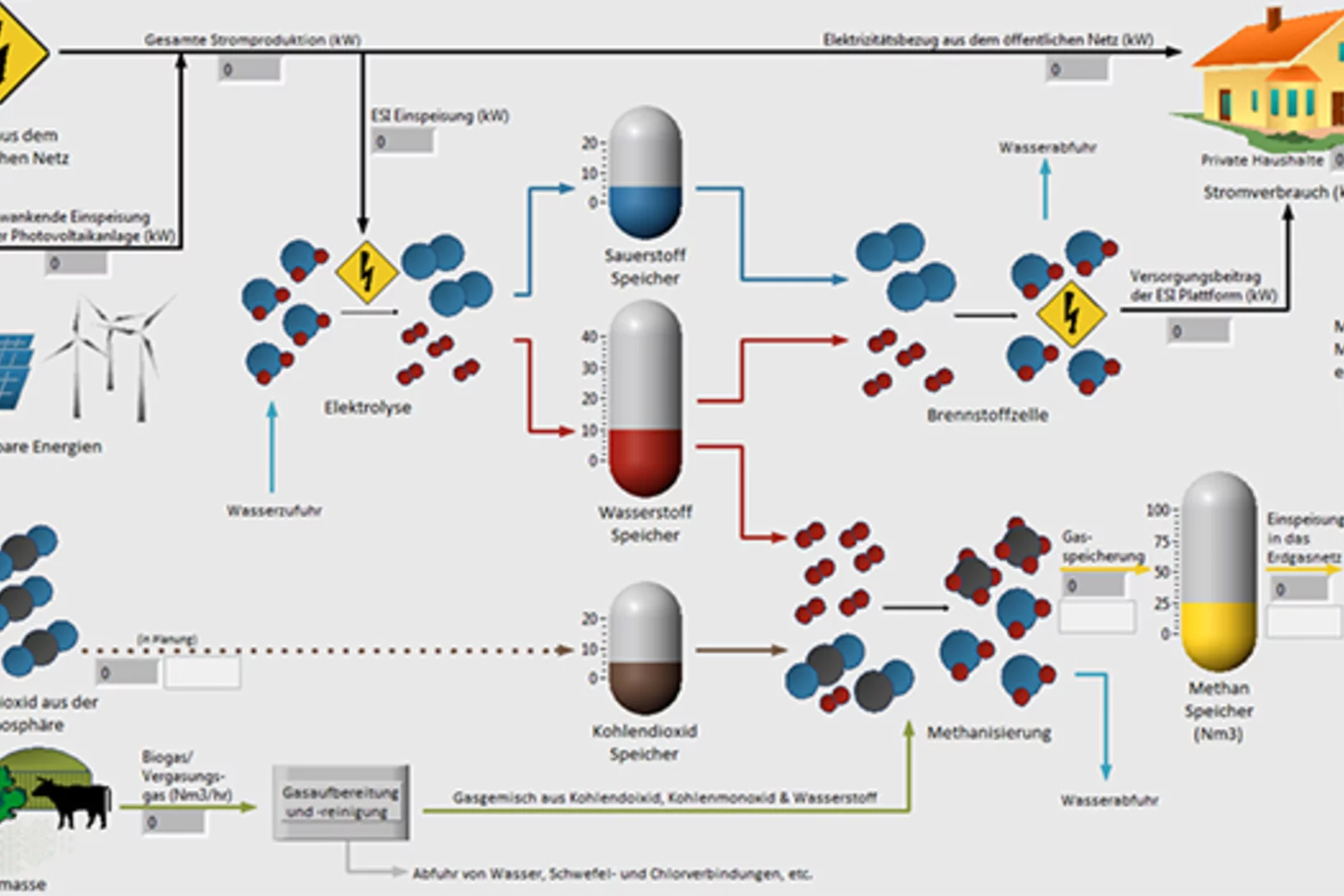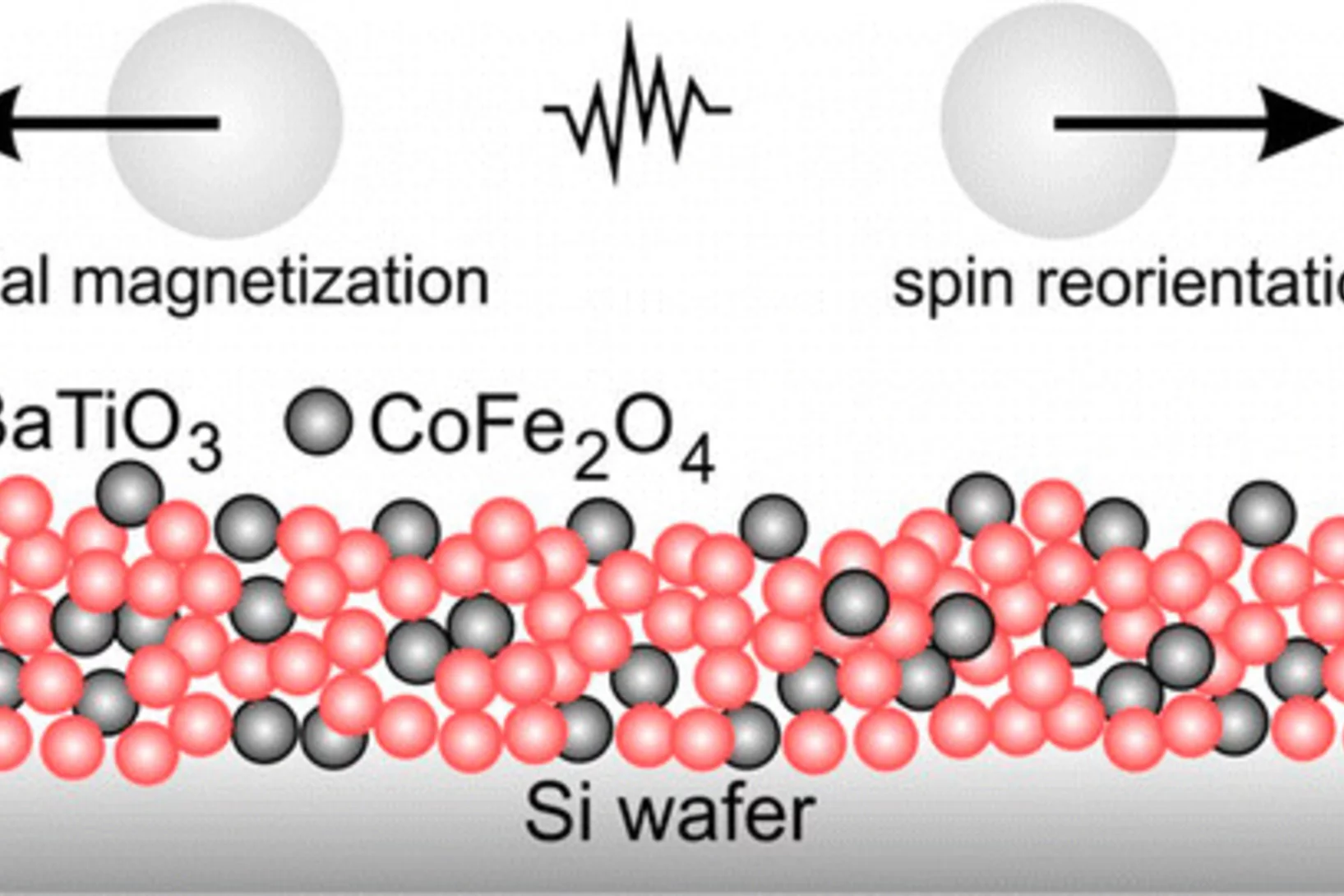Au PSI, plusieurs projets se consacrent à des questions de recherche importantes autour du coronavirus Sars-CoV-2 et des maladies qui en résultent. Nous vous informons sur les activités et les projets, par exemple sur les analyses de tissus pulmonaires, sur la production de protéines et d'anticorps ou sur les idées de nouvelles recherches sur le Covid-19.
Liens utils
X-band prototype structure
Radio-frequency structures at X-band frequencies (~ 12 GHZ) are being considered for applications in compact Free Electron Lasers, medical linacs, a future linear collider (CLIC project) and as a diagnostic for measuring ultra-short (femtosecond) electron pulses in FELs. A first prototype of such a structure has been built at PSI employing the realization procedures that have been developed for the C-Band (6 GHz) structures of the SwissFEL linac.
New TOMCAT paper: The GigaFRoST camera and readout system
The PSI in-house developed GigaFRoST high-speed camera and readout system is available for fast imaging experiments at the TOMCAT beamline, opening up exciting new possibilities for the observation of fast dynamic phenomena with X-ray tomography.
Breaking Through the False Coincidence Barrier in Electron–Ion Coincidence Experiments
The false coincidence background has so far limited the analytical application of PEPICO, photoelectron photoion coincidence. A new photoioin rastering technique has been developed to separate the wheat from the chaff and identify true coincidences based on the ion hit time and position. This expands the dynamic range of the experiment by at least two orders of magnitude, allowing for novel applications to look for reactive intermediates and short lived species in reaction environments.
Structure and Conductivity of Epitaxial Thin Films of In-Doped BaZrO3‑Based Proton Conductors
Epitaxial thin films of the proton-conducting perovskite BaZr0.53In0.47O3−δH0.47−2δ, grown by pulsed laser deposition, were investigated in their hydrated and dehydrated conditions through a multitechnique approach with the aim to study the structure and proton concentration depth profile and their relationship to proton conductivity.
EUCALL finishes first year, bearing new technologies
The European Cluster of Advanced Laser Light sources (EUCALL), a European Union-funded project that aims to foster links between accelerator- and laser-driven X-ray facilities, has completed the first year of its three year project period. The project successfully met all twenty of its milestones for the year, producing a new open-source tool for experiment simulations and developing specifications for several pieces of new scientific equipment.
The 1st LUC Retreat
The LUC team held inspiring discussions about LUC's current and future research in the relaxing atmosphere of Hotel Möschberg near Bern.
Les substances qui rendent les nuages blancs
Les nuages sont faits de minuscules gouttelettes. Celles-ci se forment lorsque l’eau se condense sur de petites particules en suspension dans l’atmosphère appelées aérosols. Pour mieux comprendre l’apparition des aérosols des chercheurs ont à présent effectué une vaste simulation numérique fondée sur des données expérimentales étendues. Or cette simulation montre qu’outre l’acide sulfurique, deux autres substances jouent un rôle décisif dans l’apparition d’aérosols: certains composés organiques et l’ammoniac. Les résultats de recherche viennent d’être publiés dans Science, la revue spécialisée renommée.
100 Hz neutron radiography at the BOA beamline using a parabolic focussing guide
The recent developments in scientific complementary metal oxide semiconductor (sCMOS) detector technology allow for imaging of relevant processes with very high temporal resolution with practically negligible readout time. However, it is neutron intensity that limits the high temporal resolution neutron imaging. In order to partially overcome the neutron intensity problem for the high temporal resolution imaging, a parabolic neutron focussing guide was utilized in the test arrangement and placed upstream the detector in such a manner that the focal point of the guide was positioned slightly behind the scintillator screen. In such a test arrangement, the neutron flux can be increased locally by about one order of magnitude, albeit with the reduced spatial resolution due to the increased divergence of the neutron beam. In a pilot test application, an in-situ titration system allowing for a remote delivery of well-defined volumes of liquids onto the sample stage was utilized. The process of droplets of water (H2O) falling into the container filled with heavy water (D2O) and the subsequent process of the interaction and mixing of the two liquids were imaged with temporal resolution of 0.01 s.
Progress in High-resolution Neutron Imaging at the Paul Scherrer Institut – The Neutron Microscope Project
The recent improvement on the capability of neutron imaging that allows acquiring neutron images with isotropic spatial resolution of about 5 micrometres is demonstrated. This is achieve by combining the tailor-made high-numerical aperture magnifying optics together with a thin isotopically-enriched 157Gd2O2S:Tb scintillator screens (see Trtik & Lehmann, NIM-A 788 (2015) 67-70). The newly achieved level of the spatial resolution represents about 30% enhancement compared to the first prototype (see Trtik et al, Physics Procedia 69 (2015) 169-176) and approximately six-fold enhancement in the spatial resolution capabilities available for the general users community at PSI before the start of the Neutron Microscope project.
Dans le microscope chimique
Entretien avec Daniel GrolimundDaniel Grolimund est responsable d’une ligne de faisceau à la Source de Lumière Suisse (SLS) du PSI. Cette ligne de faisceau permet de déterminer la répartition des liaisons chimiques dans différents objets. Une possibilité dont profitent des chercheurs de disciplines les plus diverses: spécialistes des batteries, biologistes, archéologues et bien d’autres scientifiques. Le chercheur évoque en entretien la multiplicité des thématiques étudiées à la ligne de faisceau et les défis variés dont s’accompagne cette diversité.
First protein structure solved using the JUNGFRAU detector
JUNGFRAU is a charge-integrating, two-dimensional pixel detector developed at the Paul Scherrer Institut for use at free-electron lasers, in particular SwissFEL, and synchrotron light sources. On the 10th October, the first protein crystallography experiment using the JUNGFRAU detector, was performed at the beamline X06SA (PXI) of the Swiss Light Source by the members of the Protein Crystallography and Detectors groups at PSI.
C–H Activation on Co,O Sites: Isolated Surface Sites versus Molecular Analogs
The activation and conversion of hydrocarbons is one of the most important challenges in chemistry. This work shows that isolated Co(II) sites are catalysts for a number of hydrocarbon conversion reactions, such as the dehydrogenation of propane, the hydrogenation of propene, and the trimerization of terminal alkynes. The data are consistent with all of these reactions occurring by a common mechanism, involving heterolytic C–H or H–H activation via a 1,2 addition across a Co–O bond.
First protein structure solved using the JUNGFRAU detector!
JUNGFRAU is a charge-integrating, two-dimensional pixel detector developed at the Paul Scherrer Institut for use at free-electron lasers, in particular SwissFEL, and synchrotron light sources. On the 10th October, the first protein crystallography experiment using the JUNGFRAU detector, was performed at the beamline X06SA (PXI) of the Swiss Light Source by the members of the Protein Crystallography and Detectors groups at PSI.
Novel insulating phase in iron-pnictide materials
The first example of an insulating phase which is close to the superconducting phase in an iron-pnictide system has been recently observed in heavy Cu-doped NaFe1-xCuxAs (x > 0.3). A combined study by angle-resolved photoemission spectroscopy (ARPES) and density functional theory (DFT) calculations revealed that on-site Coulomb repulsion and enhanced Hund’s rule coupling are responsible for the insulating behavior. The results show that the insulating phase in NaFe0.5Cu0.5As resembles the situation in the parent compounds of the high-Tc cuprate superconductors.
Radioactive targets produced at PSI enable improving the Big Bang Theory
One of the long-lasting unsolved problems in Nuclear Astrophysics is the so-called "Cosmological Li Problem", i.e. the large discrepancy between the primordial 7Li abundance predicted by models of Big Bang Nucleosynthesis and the one inferred from astronomical observation. The study of the production/destruction rates of the radioactive precursor 7Be is one of the clues for solving this problem.
Welcome Susanne Haselbeck
We warmly welcome Susanne Haselbeck in the Laboratory of Environmental Chemistry joining the Analytical Chemistry group as of 18th October 2016. Susanne Haselbeck is a chemical lab technician by training and will contribute to our Paleofire project by analysing black carbon in samples from various ice cores using a single particle soot photometer.
Technology award for microneedle-optofluidic sensor system
Sahan Ranamukhaarachchi, PhD student from UBC in Vancouver, won the 2016 "Brian L. Barge Award for Excellence in Microsystems Integration" for his work on a biosensing platform with integrated hollow microneedles carried out at PSI in 2015 in collaboration with Dr. Victor Cadarso and Dr. Celestino Padeste.
Kinetic studies of the Pt carbonate-mediated, room-temperature oxidation of carbon monoxide by oxygen
The kinetics involved in ambient-temperature catalytic oxidation of carbon monoxide by oxygen over a Pt/Al2O3 catalyst is evaluated under periodic redox operation using combined mass spectrometry, diffuse reflectance infrared spectroscopy and time-resolved Pt L3-edge X-ray absorption spectroscopy.
Effect of disorder on a pressure-induced z = 1 magnetic quantum phase transition
Pressure-induced ordering close to a z = 1 quantum-critical point is studied in the presence of bond disorder in the quantum spin system (C4H12N2)Cu2(Cl1−xBrx)6 (PHCX) by means of muon-spin rotation and relaxation.
24 heures sur la plateforme ESI (vidéo)
Comment rendre exploitable le courant excédentaire qui ne peut pas être injecté dans le réseau électrique? Une journée d'hiver fictive sur la plateforme Energy System Integration à l' Institut Paul Scherrer PSI.
Labile peroxides in secondary organic aerosol
Aerosols, suspended fine liquid or solid particles in the air we breathe, play a central role in many environmental processes through their influence on climate, the hydrological cycle, and their adverse effects on human health. While the mechanisms by which aerosol particles affect our health remain uncertain, the atmospheric oxidation of organic vapors has been shown to be related to the formation of oxygenated organic matter with high oxidative potential, the so-called reactive oxygen species (ROS).
Conducteur d'électricité ou isolant, au choix
L’oxyde de néodyme-nickel est un matériau qui, suivant la température, est soit un métal, soit un isolant. Cette transition peut être commandée par l’application d’une tension électrique, ce qui fait de ce matériau un candidat potentiel pour les transistors dans les appareils électroniques modernes. Des chercheurs à l’Institut Paul Scherrer PSI ont utilisé un développement perfectionné et sophistiqué de la diffusion de rayons X et réussi à saisir la cause de cette transition: la réorganisation des électrons autour des atomes d’oxygène.
Réacteurs à sels fondus: exploration d’une possibilité
À l’Institut Paul Scherrer PSI, un petit groupe de scientifiques se penche au moyen de modèles théoriques sur un modèle possible de réacteur nucléaire du futur: les réacteurs dits à sels fondus. Cette recherche contribue à assurer la place de l’expertise de la Suisse dans les questions globales, actuelles et à venir, dans le domaine de l’énergie nucléaire et de la sûreté des réacteurs.
Completion of the vacuum pipes assembly from injector to front end
On Monday October the 10th the last piece of the vacuum tube was mounted and pumped down. The about 500 m long vacuum chamber from the end of the injector to the photonics front end is now under vacuum. The only missing junction at z=119m between the already operated injector and the rest of SwissFEL will be mounted shortly before the delivery of the operation permit.
Last undulator placed in SwissFEL tunnel
On the 6th of October the last undulator for the ARAMIS beamline was placed into the SwissFEL tunnel. Thanks to the efficiency and motivation of the different groups involved with undulator preparation, all 12 undulators were assembled, measured and installed in the tunnel between the 2nd of February 2016 and the 6th of October 2016.
Aux grands instruments de recherche du PSI, les physiciens continuent à réfléchir aux théories du prix Nobel
Cette année, le prix Nobel de physique a été décerné à David Thouless, Duncan Haldane et Michael Kosterlitz. Dans son rapport de synthèse, l’Académie royale des sciences de Suède cite également des expériences menées par Michel Kenzelmann, aujourd’hui responsable de laboratoire au PSI. Avec d’autres chercheurs au PSI, ce physicien continue de mener des expériences sur la base des théories qui sont récompensées aujourd’hui par le prix Nobel.
Nanoparticle-Based Magnetoelectric BaTiO3–CoFe2O4 Thin Film Heterostructures for Voltage Control of Magnetism
Multiferroic composite materials combining ferroelectric and ferromagnetic order at room temperature have great potential for emerging applications such as four-state memories, magnetoelectric sensors, and microwave devices.
Kinetic studies of the Pt carbonate-mediated, room-temperature oxidation of carbon monoxide by oxygen over Pt/Al2O3 using combined, time-resolved XAFS, DRIFTS, and mass spectrometry
The kinetics involved in novel ambient-temperature mechanism for the catalytic oxidation of carbon monoxide by oxygen over a Pt/Al2O3 catalyst is evaluated within a periodic redox operation paradigm using combined mass spectrometry (MS), diffuse reflectance infrared spectroscopy (DRIFTS), and time-resolved Pt L3-edge XAFS. A high-wavenumber (ca. 1690 cm-1) carbonate species are shown to be associated with a room-temperature redox process occurring in a fraction of the Pt atoms present in the catalyst.
Magnetodielectric detection of magnetic quadrupole order in Ba(TiO)Cu4(PO4)4 with Cu4O12 square cupolas
In vortex-like spin arrangements, multiple spins can combine into emergent multipole moments. Such multipole moments have broken space-inversion and time-reversal symmetries, and can therefore exhibit linear magnetoelectric (ME) activity. Three types of such multipole moments are known: toroidal; monopole; and quadrupole moments. So far, however, the ME activity of these multipole moments has only been established experimentally for the toroidal moment.
Des fonds européens à hauteur de 2,6 millions de francs pour de la recherche sur les interactions fondamentales dans certains aimants
Christian Rüegg reçoit un prestigieux subside de recherche européen appelé ERC Consolidator Grant. Avec ces fonds, il entend étudier les interactions des plus petits composants de la matière.





























